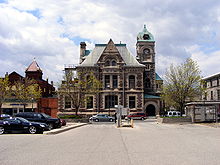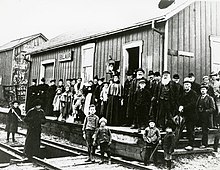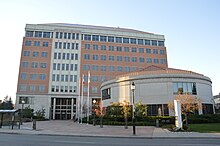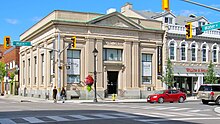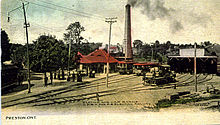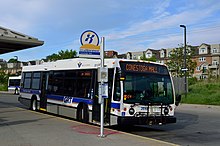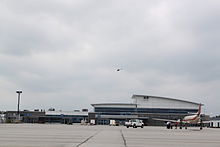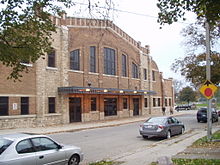Cambridge, Ontario
In the south of Cambridge when preparing for building townhouses near Myers Road in 1989, archaeologists discovered the ruins of a longhouse village dated to between 1280 and 1360 CE.
[6] They may have practiced slash and burn agriculture (as was common in the Northeastern Woodlands since 1000 CE) cultivating the Three Sisters[7] and could have been occupied by the Iroquoian speaking Chonnonton Peoples.
[10] Galt is situated on land once granted to the Iroquois people by the British Crown at the end of the American Revolutionary War.
[citation needed] One speculator, William Dickson, a wealthy immigrant from Scotland, bought 90,000 acres (360 km2) of land along the Grand River in 1816; this was later to become Galt and the Dumfries Townships.
[17] The Credit Valley Railway planned to implement several lines running west and north from Toronto and in 1873, built freight and passenger buildings in Galt.
[22] Not long after Galt had become part of Cambridge, in May 1974, flooding on the Grand River filled city streets with water to a depth of about 4 feet (1.2 m).
[23][24] The Dickson Hill Heritage Conservation District, located in West Galt, is composed of stately homes from the late 19th and early 20th centuries.
Even in the early 1800s, the area included homes, a store, an inn, small shops operated by artisans and craftsmen, mostly immigrants from Germany.
The Canadian Gazetteer of 1846 indicates a population of about 600 inhabitants, two churches, a post office that receives mail each day, a steam grist mill, and tradesmen of various types.
The Great Road between Dundas and Berlin (Kitchener) as well as the railroad connections helped the community to continue growing into an important industrial centre.
[12] While most of the population of what became Waterloo County, Ontario was Protestant in 1911, Preston had a larger share of Roman Catholics, 844, while 862 were Lutherans, 707 Methodists, 704 Anglicans, and 525 Presbyterians.
[22] The area that eventually came to be Hespeler was also on land (Block 2 measuring over 90,000 acres (360 km2) purchased in 1798 by Mennonites from Pennsylvania from the Six Nations Indians with the assistance of developer Richard Beasley.
[35] Records from 1846 indicate a population of only 100 inhabitants, a grist and a saw mill, a tannery, a tavern, one store, one pail factory, two blacksmiths, two tailors, two shoemakers.
By 1911 the electric railway system between Preston and Galt had reached Hespeler as well as Berlin (later called Kitchener) and Waterloo; by 1916 it had been extended to Brantford/Port Dover.
[43] Joseph Bowman, a man called Wismer and John Bechtel were responsible for the early development of the community in an area laid out by Benjamin B.
In addition to Carlisle, earlier names for the village had included Shinglebridge, because a bridge with a shingle roof crossed the Grand River in this area from 1853 to 1857.
The hospital summarized the plan as follows in 2013: "This transformation includes a larger Emergency Department and a 33% increase in beds to accommodate expanded mental health, medicine, surgery, birthing programs and so much more".
A news report on 29 December 2018 stated that "After two decades of planning and community fundraising, the expansion project, promising 54 new beds and a twice-as-large emergency department, is not quite half-complete and stalled".
[58] [59] Part of the hospital expansion, the new patient care wing, was completed in mid-November 2019 and was scheduled to open in January 2020, after new equipment has been installed and staff have been trained.
Notable television series filmed in Cambridge include Murdoch Mysteries (2008–), Between (2015–2016), Bitten (2014–2016), 11.22.63 (2016), The Handmaid's Tale (2017–), Designated Survivor (2016–), V-Wars (2019–), The October Faction (2019–) and American Gods (2017–).
[72] The new project will not house physical print but focus on 3D & laser printers, maker labs, performance and studio for teen, a large children's area including a Lego wall and a coffee shop.
[72] The Federal and Ontario governments and the City of Cambridge came together and built the Dunfield Theatre in 2013 in an effort to promote Canadian talent and the performing arts.
A four-story "living wall" of tropical plants is located in the atrium and cleanses the air of pollutants such as formaldehyde, volatile organic compounds, dust, and spores.
Behind the living wall is a running water supply that provides humidity during the winter months and a soothing sound for employees and visitors to enjoy all year round.
In the tradition of environmental stewardship, Cambridge preserves over 365 hectares (900 acres) of parkland which make up more than 80 parks in the city, as well as over 140 kilometres (87 mi) of on-road cycling lanes.
A number of strategies were investigated to alleviate delays caused by trains and as of December 2012 construction of a bridge over Hespeler Road commenced, and was completed 18 months later.
Although freight trains serving the Toyota factory are a common sight in Cambridge, the city at present has no passenger rail service.
[89] In Phase 1, which started operating in 2019, the Ion LRT runs between Waterloo and Kitchener, passing through the downtown and uptown areas of the two cities.
At least one journalist has pointed out the similarity between this plan and the electric Grand River Railway of the early 1900s that connected Cambridge, Kitchener, and Waterloo.
[101] In 2018, citing the inability to successfully negotiate with Canadian Pacific for further access for passenger trains along the Galt Subdivision, regional and municipal governments, along with Metrolinx and the Ministry of Transportation, began to pursue a possible passenger rail connection to the Kitchener line at Guelph Central Station, using the existing CN Fergus Subdivision to reach it.
